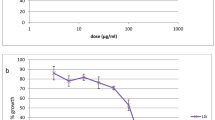Abstract
Malaria is one of the world's leading killer infectious diseases with high incidence and morbidity. The problem of multidrug-resistant Plasmodium falciparum has been aggravating particularly in Southeast Asia. Therefore, development of new potential antimalarial drugs is urgently required. The present study aimed to investigate antimalarial activities of a total of 27 medicinal plants and 5 herbal formulations used in Thai traditional medicine against chloroquine-resistant (K1) and chloroquine-sensitive (3D7) P. falciparum clones. Antimalarial activity of the ethanolic extracts of all plants/herbal formulations against K1 and 3D7 P. falciparum clones was assessed using SYBR Green I-based assay. All plants were initially screened at the concentration of 50 μg/ml to select the candidate plants that inhibited malaria growth by ≥50 %. Each candidate plant was further assessed for the IC50 value (concentration that inhibits malaria growth by 50 %) to select the potential plants. Selectivity index (SI) of each extract was determined from the IC50 ratio obtained from human renal epithelial cell and K1 or 3D7 P. falciparum clone. The ethanolic extracts from 19 medicinal plants/herbal formulation exhibited promising activity against both K1 and 3D7 clones of P. falciparum with survival of less than 50 % at the concentration of 50 μg/ml. Among these, the extracts from the eight medicinal plants (Plumbago indica Linn., Garcinia mangostana Linn., Dracaena loureiri Gagnep., Dioscorea membranacea Pierre., Artemisia annua Linn., Piper chaba Hunt., Myristica fragrans Houtt., Kaempferia galanga Linn.) and two herbal formulations (Benjakul Formulation 1 and Pra-Sa-Prao-Yhai Formulation) showed potent antimalarial activity with median range IC50 values of less than 10 μg/ml against K1 or 3D7 P. falciparum clone or both. All except G. mangostana Linn. and A. annua Linn. showed high selective antimalarial activity against both clones with SI > 10. Further studies on antimalarial activities in an animal model including molecular mechanisms of action of the isolated active moieties are required.
Similar content being viewed by others
References
Azebaze AG, Meyer M, Valentin A, Nguemfo EL, Fomum ZT, Nkengfack AE (2006) Prenylated xanthone derivatives with antiplasmodial activity from Allanblackia monticola STANER L.C. Chem Pharm Bull 54(1):111–113
Bennett TN, Paguio M, Gligorijevic B, Seudieu C, Kosar AD, Davidson E, Roepe PD (2004) Novel, rapid, and inexpensive cell-based quantification of antimalarial drug efficacy. Antimicrob Agents Chemother 48:1807–1810
Chu D, Miles H, Toney D, Ngyuen C, Marciano-Cabral F (1998) Amebicidal activity of plant extracts from Southeast Asia on Acanthamoeba spp. Parasitol Res 84(9):746–752
Connolly JD, Deans R, Haque ME (1995) Constituents of Piper chaba. Fitoterapia 66(2):188
Durga R, Sridhar P, Polasa H (1990) Effects of plumbagin on antibiotic resistance in bacteria. Indian J Med Res 91:18–20
Firestone GL, Sundar SN (2009) Anticancer activities of artemisinin and its bioactive derivatives. Expert Rev Mol Med 11:e32
Lambros C, Vanderberg JP (1979) Synchronization of Plasmodium falciparum erythrocytic stages in culture. J Parasitol 65(3):418–420
Likhitwitayawuid K, Chanmahasathien W, Ruangrungsi N, Krungkrai J (1998a) Xanthones with antimalarial activity from Garcinia dulcis. Planta Med 64(3):281–282
Likhitwitayawuid K, Kaewamatawong R, Ruangrungsi N, Krungkrai J (1998b) Antimalarial naphthoquinones from Nepenthes thorelii. Plant Med 64(3):237–241
Likhitwitayawuid K, Sawasdee K, Kirtikara K (2002) Flavonoids and stilbenoids with COX-1 and COX-2 inhibitory activity from Dracaena loureiri. Plant Med 68(9):841–843
Lin LC, Yang LL, Chou CJ (2003) Cytotoxic naphthoquinones and plumbagic acid glucosides from Plumbago zeylanica. Phytochemistry 62(4):619–622
Morita T, Jinno K, Kawagishi H, Arimoto Y, Suganuma H, Inakuma T, Sugiyama K (2003) Hepatoprotective effect of myristicin from nutmeg (Myristica fragrans) on lipopolysaccharide/d-galactosamine-induced liver injury. J Agric Food Chem 51(6):1560–1565
Na-Bangchang K, Congpuong K (2007) Current malaria status and distribution of drug resistance in East and Southeast Asia with special focus to Thailand. Tohoku J Exp Med 211:99–113
Na-Bangchang K, Ruengweerayut R, Muhamad P, Chaijaroenkul W (2010) Declining in efficacy of a three-day combination regimen of mefloquine-artesunate in a multi-drug resistance area along the Thai–Myanmar border. Mal J 8:273–280
Noedl H, Se Y, Schaecher K, Smith BL, Socheat D, Fukuda MM (2008) Artemisinin Resistance in Cambodia 1 (ARC1) Study Consortium. Evidence of artemisinin-resistant malaria in western Cambodia. N Engl J Med 359(24):2619–2620
Parimala R, Sachdanandam P (1993) Effect of plumbagin on some glucose metabolizing enzymes studied in rats in experimental hepatoma. Mol Cell Biochem 125(1):59–63
Rasoanaivo P, Deharo E, Urverg SR, Frappier F (2004) Guidelines for the nonclinical evaluation of the efficacy of traditional antimalarials. In: Willcox M, Rasoanaivo P, Bodeker G (eds) Traditional medicinal plants and malaria. CRC Press, Boca Raton, Chapter 16
Riscoe M, Kelly JX, Winter R (2005) Xanthones as antimalarial agents: discovery, mode of action, and optimization. Curr Med Chem 12(21):2539–2549
Saekoo J, Graidist P, Leeanansaksiri W, Dechsukum C, Itharat A (2010) Dioscorealide B from the traditional Thai medicine Hua-Khao-Yen induces apoptosis in MCF-7 human breast cancer cells via modulation of Bax, Bak and Bcl-2 protein expression. Nat Prod Commun 5(12):1921–1926
Schwikkard S, van Heerden F (2002) Antimalarial activity of plant metabolites. Nat Prod Rep 19(6):675–692
Sudhanshu S, Neerja P, Jain DC, Bhakuni RS (2003) Antimalarial agents from plant sources. Curr Sci 85(9):1314–1329
Sugie S, Okamoto K, Rahman KM, Tanaka T, Kawai K, Yamahara J, Mori H (1998) Inhibitory effects of plumbagin and juglone on azoxymethane-induced intestinal carcinogenesis in rats. Cancer Lett 127(1–2):177–183
Trager W, Jensen JB (1976) Human malaria culture parasite in continuous culture. Science 193:673–675
Wang YC, Huang TL (2005) High-performance liquid chromatography for quantification of plumbagin, an anti-Helicobacter pylori compound of Plumbago zeylanica L. J Chromatogr A 1094(1–2):99–104
World Health Organisation (2006) Guidelines for the treatment of malaria. Geneva, WHO, HTM/MAL/110
Acknowledgments
The study was supported by Thammasat University; The Commission on Higher Education, Ministry of Education of Thailand; and The National Research University Project of Thailand (NRU), Thailand Research Fund (TRF), Office of Higher Education Commission.
Author information
Authors and Affiliations
Corresponding author
Rights and permissions
About this article
Cite this article
Thiengsusuk, A., Chaijaroenkul, W. & Na-Bangchang, K. Antimalarial activities of medicinal plants and herbal formulations used in Thai traditional medicine. Parasitol Res 112, 1475–1481 (2013). https://doi.org/10.1007/s00436-013-3294-6
Received:
Accepted:
Published:
Issue Date:
DOI: https://doi.org/10.1007/s00436-013-3294-6




